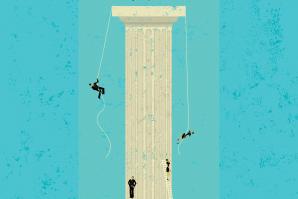Gov. Jerry Brown’s tax measure would raise sales taxes by one-quarter of a percent for four years and increase taxes on incomes of $250,000 or higher by 1 to 3 percentage points for seven years.
Brown claims failure of the November tax measure would result in a $5.5 billion cut to schools and 15 days removed from the school year.
That’s not necessarily true. The governor has asked school budget architects to assume the November tax measure will pass. That way, tax supporters can coalesce around the message that schools would be forced to implement sweeping layoffs and other drastic maneuvers if the measure fails.
But when the nonpartisan Legislative Analyst’s Office (LAO) recently polled about half the state’s school districts, 90 percent of respondents said they would budget for the 2012-2013 school year assuming the measure would fail. In other words, the pink slips have already been sent out. This is less a function of educators wishing to detract from the governor’s public relations campaign and more due to the logistics of implementing cuts.
As for the overall hit to schools, $2.6 billion of the $5.5 billion reduction is actually an injection of funding that was promised to schools in prior years but postponed. That is to say, the raise that schools were told to expect in 2012-2013 would not materialize. If the tax measure fails, the net reduction to K-12 school budgets would be closer to $2.9 billion, according to the LAO.
Finally, the notion that California schools would be forced to cut 15 days of teaching also would be a challenge because local teacher unions would have to agree to those cuts. Similar past efforts have been blocked.
HOW MUCH HAVE SCHOOLS BEEN CUT ALREADY?
For the past few years, education interest groups have publicized
that schools lost $20 billion during the budget crisis. That
figure is based on several far-reaching assumptions, including
annual cost-of-living raises that were never even proposed. An
LAO report states “total expenditures dropped by $3.3 billion
between 2007-08 and 2010-11.” Spending on teachers and
administrators dropped by $2.3 billion, and spending on books and
supplies dropped by $1 billion, or 22 percent. Although statewide
data is not yet available, many districts say they have made
further cuts in this most recent school year.
To get a sense of the total public education budget, note that the state spends roughly $50 billion each year on K-12 schools and community colleges through its general fund, but the number fluctuates by billions each year based on incoming tax revenues and state budget negotiations. The state funding method is based on a revenue calculation that has little or nothing to do with how much money schools actually need to educate children. Funding from the California Lottery provides roughly $1 billion per year, less than 2 percent of total K-12 funding.
An estimated 32,000 teaching jobs have been lost since 2008, down from about 300,000 total jobs that existed before the recession.
Teacher salaries and benefits constitute about 80 percent of statewide school expenditures, so most of the cuts are reflected in workforce reductions. In recent years, some school districts have also cut support staff, such as counselors and speech therapists, and reduced the school year and staff workdays. According to the LAO, “Data suggests districts actually have cut programs even more deeply in order to accommodate increasing costs associated with local teacher contract provisions and health benefits contributions.”
WHY ARE TEACHER COSTS GOING UP?
Because the cost of health care is increasing everywhere.
Teachers do not participate in the state health benefits system.
Instead, school districts shop in the private market, where
national costs have increased 6 percent annually on average. Some
employers have reduced contributions and post-retirement health
benefits for new teachers, but those decisions are subject to
collective bargaining and have been uncommon.
Also, many teacher salaries are automatically increased each year based on experience or level of professional education. Only a small fraction of districts reported stopping this “step-and-column” practice in recent years. The rest technically had to employ cuts just to maintain the same spending levels.
WHAT DOES THIS MEAN FOR CALIFORNIA TEACHERS?
An estimated 32,000 teaching jobs have been lost since 2008, down
from about 300,000 total jobs that existed before the recession.
Those losses include layoffs, retirees whose positions were never
backfilled and teachers leaving the field. Due to seniority laws,
many of these losses were targeted at younger educators teaching
in low-income areas. Looking forward, the number of teachers
entering the profession is shrinking significantly and experts
warn of a teacher shortage in coming years.
IF THE RESULT OF AN UNSUCCESSFUL TAX MEASURE HAS BEEN
EXAGGERATED, WHAT IS THE REAL IMPACT?
Schools would likely have to further reduce their workforce and
make corresponding increases to class sizes. Statewide, average
class sizes in kindergarten through third grade have grown from
23 to 26 students, and from 30 to 32 students in seventh through
12th grade — but some classrooms are packed with close to 40
kids.
A failed tax measure would also further complicate how lawmakers would pay for national English and math standards the state adopted in 2010. The new standards completely overhaul California’s current system; the needed books and supplies and teacher training are expected to cost billions, and the state’s ability to meet benchmarks may be tied to future federal dollars. Whether Brown’s tax measure passes or not, its unclear how California will fund the incoming “common core” standards.
BUT MY NEIGHBORHOOD SCHOOL DISTRICT DOESN’T APPEAR TO BE
IN SUCH A DIRE PREDICAMENT. DO THEY FOLLOW A BETTER BUSINESS
MODEL?
It depends. California school districts can be characterized as
haves and have-nots due to a mixture of geographic affluence and
local school board budgeting decisions. Districts that are now
facing insolvency in many cases failed to implement necessary
personnel reductions — often due to blockage by teacher unions.
According to state projections, a record 188 districts, charter schools and alternative schools are now in danger of not meeting financial obligations over the next three years. Twelve of those agencies have more dire projections and are expected to fail. A school district insolvency can trigger an emergency loan from the state Legislature, and it is unknown how the state would cover a large increase in those costs. In the Capital Region, districts at risk of financial failure include Natomas Unified, Sacramento City Unified and Folsom-Cordova Unified.
Recommended For You
The Case Against New Taxes
Why dampen consumer spending or endanger small businesses?
Taxes are en vogue these days, and not just at the state level where Gov. Jerry Brown is pushing a sales and income tax ballot measure. Eight California cities already gained general tax increases from their residents in the June elections; several more cities and counties will attempt to follow suit in November.

Numbers Game
Gov. Brown's tax initiative rides on voter turnout
The key issue for California’s 2012 election is turnout. The presidential election, a key motivator for voters, might be of little help this year. It’s not shaping up to be a persuasion election, despite the millions being spent on advertising. And because it’s not a battleground state, California could see participation wane.



